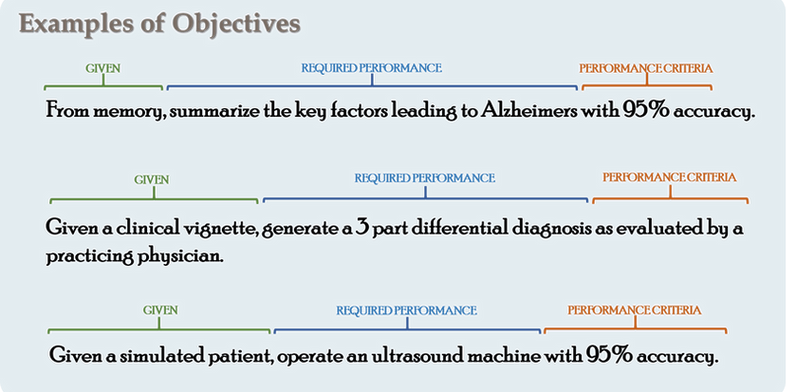CREATING GREAT PERFORMANCE OBJECTIVES
Ends are much more important than means. They come first. Before you decide how you are going to do a thing, you have to determine what it is you want to achieve.
Ends are ultimate, the means for achieving those ends are penultimate.
The end is the important thing, everything else comes later.
Before you design the first learning experience, you must define what it is the learner will be able to do at the end of it. We define the ends of instruction in terms of objectives. It is helpful to call them "performance" objectives because even if the performance is cognitive, it can be defined in terms of what the learner will be able to do because of the instruction.
Be creative here... An objective should describe the thing you will see if the learner has learned what you have taught. Objectives should contain a verb describing what it is the learner will actually do.
The Three Parts of an Objective
Part One: The “Givens” (When will the learner do this?)
When you describe the givens of an objective, you are describing the conditions in which the student will perform the skill or need the knowledge. This is important from two perspectives. First, an important part of any skill is knowing when to perform it. This "given" part of the objective helps clarify when the student will do this. Further, knowledge or skill doesn't exist in a vacuum, there must be a context for it. The "given" part of an objective describes this context for the performance. In the MD Program at EVMS, because so many assessments are multiple choice exams, it is acceptable to not state the given if it is "Given a multiple choice exam..."
Examples:
-
Given a simulated patient...
-
After generating a differential diagnosis...
-
Given a clinical vignette...
-
Given a cadaver...
-
Given an ultrasound image...
Part Two: The Required Performance (What will the learner be able to do?)
We describe the required performance in terms of a verb (a thing the student will do) and a noun (what they will do it to).
Examples of performances:
-
Draw a map
-
Set a bone
-
Generate a diagnosis
-
Suture a wound
-
Capture a clear and useful ultrasound image
-
Identify a muscle group
-
Identify the process for...
-
Identify the interaction of...
-
Identify the best differential diagnosis...
The New Bloom’s Taxonomy table accessible from the button in the gray box at the top of this page provides many examples of verbs that can be used in writing objectives.
Part Three: The Performance Criteria (How well must the learner do this?)
As we have said, an objective tells you when the student will perform an action. It will tell you what the action is. And it must also describe how well the student must perform it. That is, it must describe the required criteria for performance.
This is the answer to the question: How well do the students have to do this thing?
Criteria can be described in terms of a particular type of person’s judgment (e.g., a practicing physician) or it may be in terms of accuracy against some standard (e.g., 95% in 20 trials using the EVMS checklist for setting a bone).
Examples of performance criteria:
-
...in accordance with EVMS standard procedures.
-
...as evaluated by a practicing physician.
-
...with 70% accuracy on a multiple choice exam.
-
...with 100% accuracy against the AMA standards.
-
...without making a mistake.

An attempt at (dark) humor... (Request your forgiveness!)
From a class I once taught.

More Examples of Objectives
The following examples provide an idea of how to articulate the givens, the performance and the performance criteria for various types of objectives.
-
Given a simulated compound fracture, set bone in accordance with course checklist with 97% accuracy.
-
Given a service learning experience, map the health determinants ecosystem highlighting risk areas for the service learning recipients with 90% accuracy in accordance with module checklist.
-
Given 10 x-ray film frames, interpret the 10 images with 95% accuracy on a multiple choice exam.
-
Given a cadaver, identify the 15 dominant muscles in the lower back with 95% accuracy on a lab exam.
-
Given a cadaver, create a process drawing of the healthy operation of a knee joint including all relevant bone structures and ligaments satisfactorily as judged by module director.
-
Given a detailed patient history, predict the probability that a patient will exhibit a prevalent family disease with 90% accuracy as measured against EVMS checklist standards on a multiple choice exam.
-
Given a post medical school survey, respond with agree or strongly agree to the statement: "I have grown in my respect for persons over the last four years."
-
After having produced a differential diagnosis, defend the diagnosis before a panel of peers, as evaluated by a practicing physician.
-
Given a complex clinical vignette and two minutes preparation time, present a simplified summary of the medical situation to a simulated family member including 95% of the relevant details in plain language as evaluated using the EVMS clinical skills rubric.
-
Given a clinical vignette on a multiple choice exam, identify the steps for drawing blood for an A1C test with 100% accuracy.
-
Given a clear photograph, identify the four key muscular regions of the back with 100% accuracy on a multiple choice exam.
From a class I taught... This video describes the process of developing performance goals and objectives. Please disregard the reference to the textbook. Hope this is helpful.
